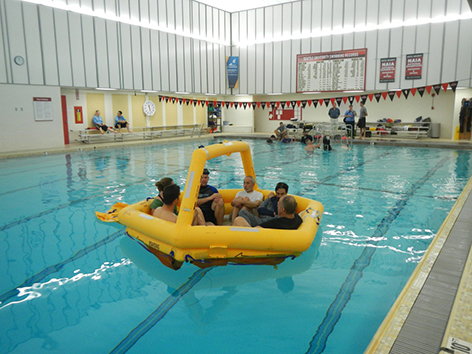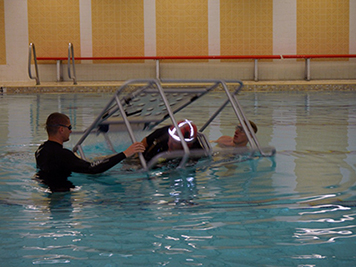How to Survive an Upside-Down Helicopter Crash in the Ocean? Practice

JULY 26, 2013 -- "To the count of three, we roll you over. Ready? One, two, and—roll!" This is what 32 NOAA emergency response staff heard when they went through what has become an integral part of their safety training since 1999: The practice of safely exiting an upside-down, underwater helicopter using emergency Survival Egress Air (SEA) bottle systems. SEA bottles are like small, portable SCUBA bottles that fit into a Personal Flotation Device vest. Because many Office of Response and Restoration staff participate in helicopter overflights during oil spill responses, this is important training to have in case an emergency occurred while flying over the ocean. We worked with four rescue swimmers from the U.S. Coast Guard Air Station Port Angeles and in close collaboration with Seattle University staff to carry out this training in a racing pool at the university. They used a frame-encased floating chair, which simulated a helicopter seat. Everyone sat in the floating framed seat, put on a helmet (safety first!), buckled up, and when the chair rolled upside-down into the water, we had to unbuckle the five-point seat belt and exit the "helicopter" while using emergency air in the SEA. Sounds like fun? It was to some, though less so to others, but everyone passed the training, got an adrenaline rush, and had an opportunity to become more familiar with the equipment that could save their lives. The exceptionally professional team of Coast Guard rescue swimmers also coupled the helicopter exit training with offshore survival skills, which include getting into a life raft and a refresher on the use of various types of other survival equipment. Just a day before, we learned about open water survival and helicopter egress (exit) training from the Coast Guard to prepare us for the "dip" in the pool. They hit on several key points for surviving a helicopter water crash and included personal stories that taught important survival lessons. Specifically, the Coast Guard covered the "Seven Steps to Survival":
- Recognition: Recognize that a bad situation is unfolding and that you are in trouble. Do something about it!
- Inventory: Decide what to do next, and what you have with you that will help you survive.
- Shelter: Protect your body and get out of the water as much as you can. Your clothing choice is your first key to shelter.
- Signal: Make yourself visible to rescuers.
- Water: Keep yourself hydrated.
- Food: If you have water, keep yourself sustained with food.
- Play: Stay busy and keep your mind occupied. Continue working toward getting saved.
Having the right equipment is key to survival, but it isn’t much good if you don’t know how to use it properly. In addition to the action-packed pool training, we familiarized ourselves with the SEA air bottles and the MOLLE (a modular, adjustable vest used to hold the SEA) thanks to the help of Aerial Machine and Tool Company representative Butch Flythe. Butch is a retired Coast Guard Chief, expert on survival equipment, and also was part of the very first group of Coast Guard rescue swimmers when the program launched in 1985. Buckling up when we drive, practicing evacuation from a building, and training safe exit from a downed helicopter are all safety measures we take hoping that we will never need to use them but knowing that if practiced, they could someday save our lives. You can learn about how real-time ocean data from NOAA is aiding Coast Guard search and rescue operations in the video podcast below.

